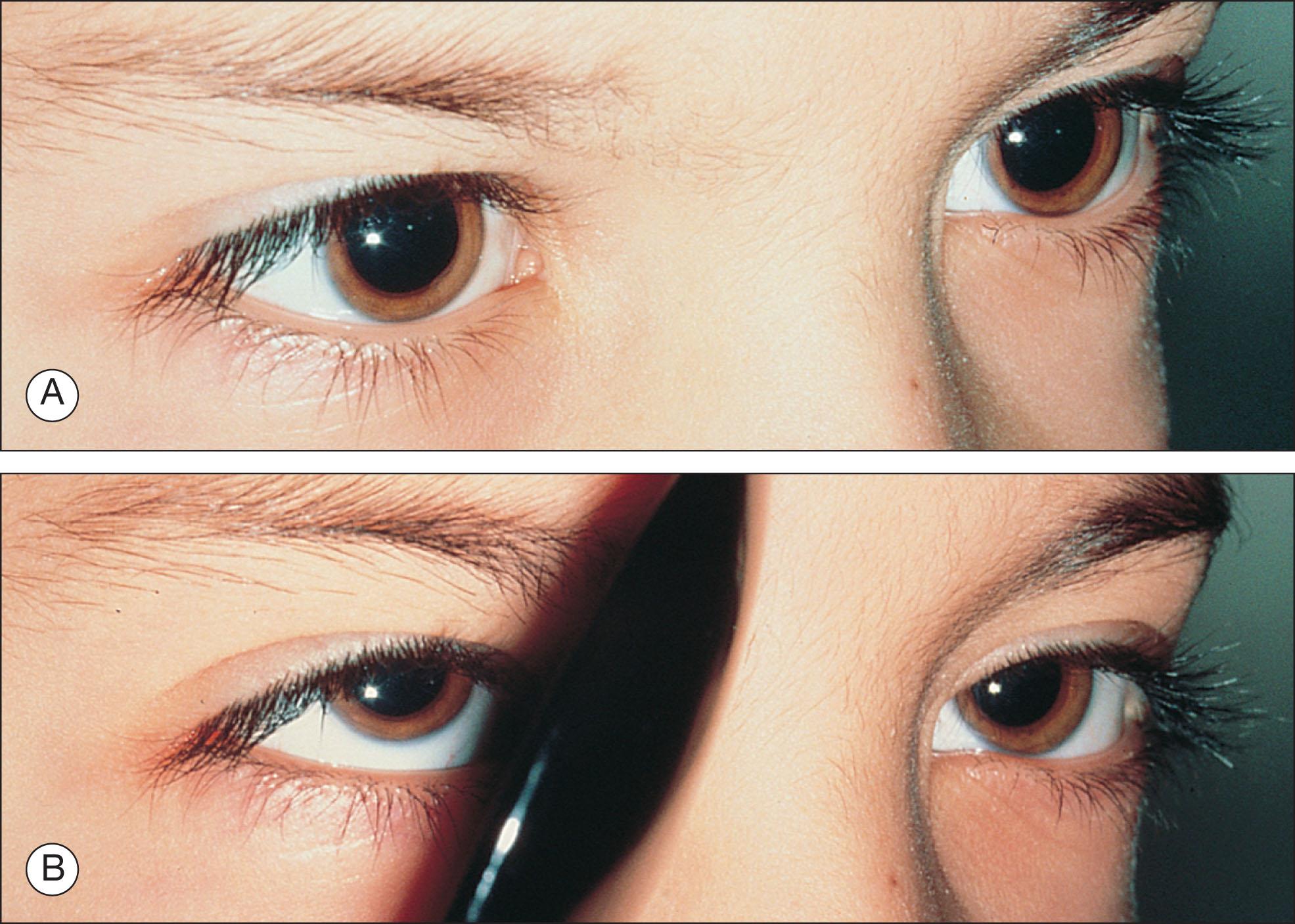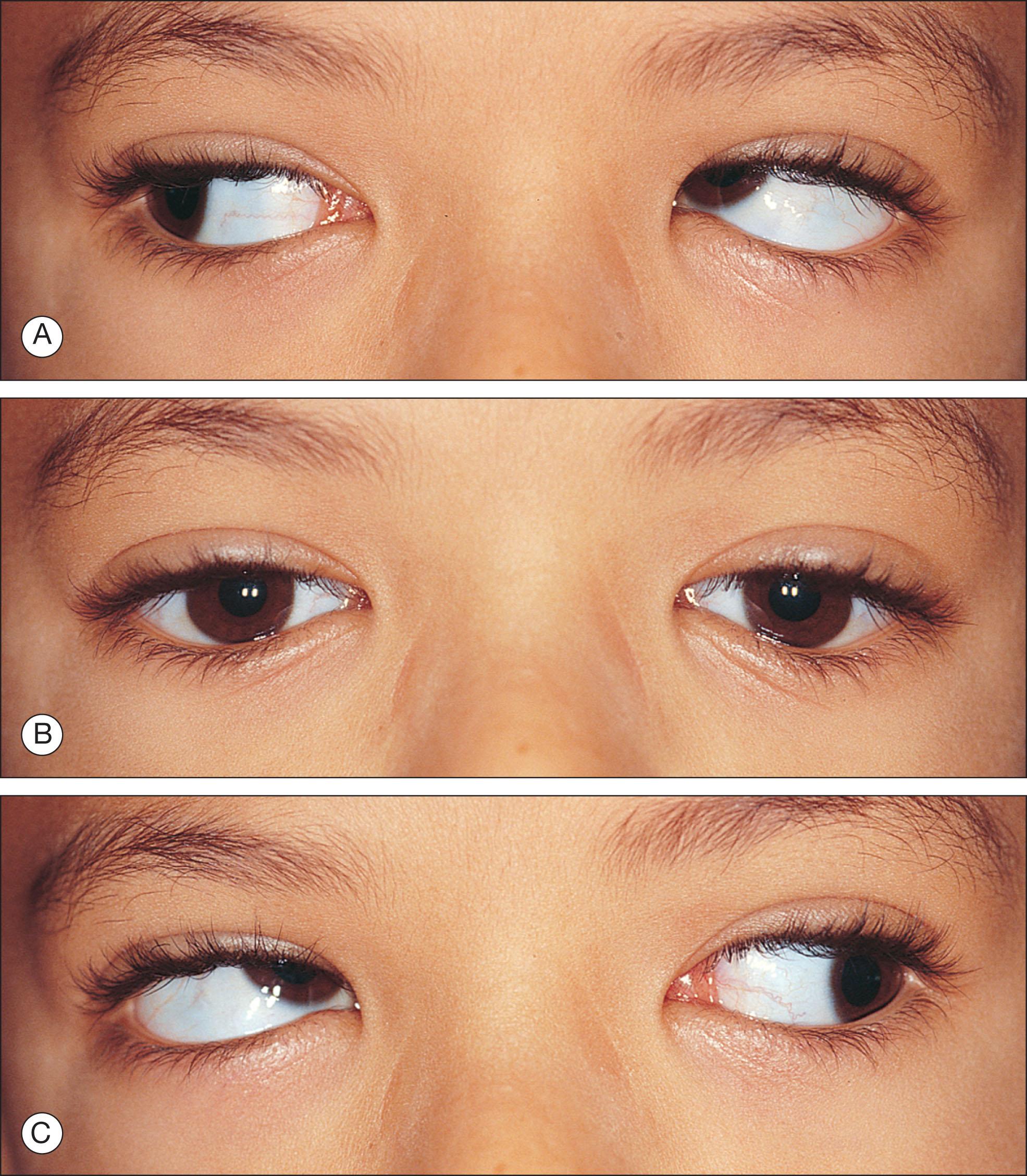Physical Address
304 North Cardinal St.
Dorchester Center, MA 02124
Vertical strabismus not paretic in origin.
Incomitance.
Supranuclear or mechanical causation.
The various findings in nonparetic vertical strabismus can be grouped into several clinical entities. All share incomitance as a feature. The causes are multiple and include supranuclear, strabismic, mechanical, restrictive, and muscle fibrosis.
Dissociated vertical divergence (or dissociated vertical deviation [DVD]) is characterized by a spontaneous upward deviation of either eye (dissociation) while the other eye fixates on a target ( Fig. 11.10.1 ). The deviation is variable within an episode and from one dissociated episode to another. After a period of usually no more than a few tenths of a second or on a shift of gaze, the eye returns down and typically becomes transiently mildly hypotropic. The amplitude of the deviation and the frequency of spontaneous dissociation usually are not equal in the two eyes. The spontaneous deviation may occur with or without daydreaming or fatigue, although these states make the deviation worse or the spontaneous dissociation more common.

Although DVD is most common with infantile esotropia, it can occur with any horizontal strabismus and sometimes as an isolated defect. Seldom present at birth, DVD frequently is a new finding after the age of 2–3 years and is thought to be associated with the early disruption of binocular development. Elevation in adduction, which produces an apparent inferior oblique muscle overaction, can be the initial presentation. Fusion maldevelopment syndrome (FMS; latent or manifest latent nystagmus) commonly occurs with DVD in infantile esotropia.
In cover testing, the eye drifts upward and outward and excyclorotates behind the occluder. The eye then returns downward when the occluder is removed and fixation restored. The uncovered eye typically remains stationary. Binocular visual input thus plays a role in stabilization of the eyes in the primary position, although the deviation can occur with inattention or be manifest. Because the deviated eye usually is suppressed, diplopic symptoms seldom occur. Rarely, the suppression is not deep enough, and vertical diplopia occurs. Occasionally, a patient may find it physically uncomfortable for the eye to turn upward. The spontaneous deviation may also disturb psychosocial function.
Because each eye drifts upward under cover and moves downward on removal of the cover, it is difficult to get an accurate measurement of the vertical deviation of DVD. Thus the prism power that makes the residual vertical drift symmetrical can be used as an estimate. Occasionally, the drift movement is chiefly horizontal, and the term dissociated horizontal deviation is used. If it is primarily torsional, the term dissociated torsional deviation is used.
The cause of DVD is the subject of much speculation. The normal versions and ductions imply a defect in supranuclear control of eye position with an abnormal vertical vergence system. The Bielschowsky phenomenon is a characteristic of DVD demonstrated by an upward deviation when the eye is occluded. When a neutral-density wedge is placed before the opposite unoccluded eye, the eye behind the cover makes a gradual downward movement in proportion to the attenuation of light that reaches the open eye. This phenomenon sometimes becomes manifest in a blind or significantly visually impaired eye. More recent work, however, suggests that DVD is driven primarily by fixation and less so by binocular luminance disparity.
The characteristic findings in DVD eliminate the need for any differential diagnosis except in cases that have minimal involvement, concurrent vertical deviation, or difficulty in examination because of the patient’s young age. Overaction of the inferior oblique (primary or secondary) muscle and superior oblique muscle paresis must be ruled out. In cases of vertical strabismus, a coexisting DVD may be difficult to diagnose.
Although binocular sensory and motor fusional capacity is poor in DVD, the aim of nonsurgical therapy for DVD is to strengthen the patient’s fusional mechanisms. This is done by elimination of any concurrent strabismus and optimization of vision through accurate refractive prescription and the treatment of amblyopia. Indications for surgery are visual symptoms, physical discomfort from a large deviation, or disfigurement produced by the updrift. Various surgical procedures have been advocated for DVD. These include resection of the inferior recti, recession of the superior recti with or without a Faden (posterior fixation) procedure, and anterior transposition of the inferior oblique. If one eye is used habitually for fixation, surgery needs to be performed only on the opposite eye. If either eye is used at times for fixation, both eyes need to be operated on in proportion to each eye’s quantitative drift, leading to the potential for asymmetrical surgery. Dissociated horizontal deviation can be corrected by lateral rectus recession on the involved side.
Overelevation in adduction may be the result of primary overaction of the inferior oblique muscles. The cause is unknown, although it is associated with horizontal strabismus. An anatomical variation plays a role because it can be seen in craniosynostosis. A difference in the plane of action of the superior and inferior oblique muscles may leave the inferior oblique with a stronger vertical action in adduction than the superior oblique muscle. Excyclorotation of the globe or orbit may raise the insertion of the medial rectus above the horizontal midline to give it a vertical action that assists elevation in adduction and simulates inferior oblique muscle overaction.
Primary inferior oblique muscle overaction refers to a marked elevation of an eye when in the adducted position under binocular viewing conditions ( Fig. 11.10.2 ). Usually, no vertical deviation occurs in the primary position. When bilateral, a right hypertropia is seen in left gaze and a left hypertropia in right gaze. The elevation in adduction may be bilaterally symmetrical or asymmetrical. The head-tilt test result is negative, and depression on adduction is normal. It is typically associated with a horizontal strabismus, either an esotropia or exotropia, and produces a V pattern (see Chapter 11.8 ).

Become a Clinical Tree membership for Full access and enjoy Unlimited articles
If you are a member. Log in here